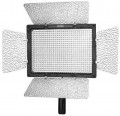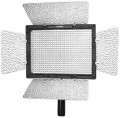Colour temperature
The colour temperature of the light emitted by the device. Most of the classic flashes have a standard colour temperature of 5500-5600 K, so this parameter is usually not given for such lamps. But on-camera light sources (see "Type") can differ markedly in this indicator, and we will talk about them.
Colour temperature characterizes the overall shade of the glow emitted by the device. At the same time, an interesting nuance is that low values \u200b\u200bcorrespond to colours that a person perceives as warm; and as the colour temperature rises, the hue shifts more and more towards cool colours. For example, for a 60 W incandescent lamp, the light of which has a pronounced yellowish colour, this parameter is approximately 2700 K, and for a fluorescent lamp that produces “daylight” light with a bluish tint, this parameter is about 7000 K.
In general, the colour temperature of lighting is one of the most important parameters when shooting: it determines the colour balance of the image "seen" by the camera. In camera settings, this indicator is called "white balance". It can also be determined automatically, however, for the most reliable colour reproduction, it is still desirable to set its values according to the known colour temperature of the lighting.
Specifically, in on-camera light sources, the colour temperature can be either constant or adjustable. In non-adjustable models, the value of this parameter is the same as in most flash units...— 5500 K, which corresponds approximately to neutral white. Adjustment also provides the possibility of at least lowering the colour temperature — usually up to 3200 K, which approximately corresponds to warm white light. In addition, occasionally there are models in which the maximum colour temperature exceeds 5500 K, reaching 6000 K and even more.
The ability to change the colour temperature can be useful not only for shooting as such, but also for “matching” the lamp with other light sources. The fact is that if several simultaneously used light sources have different colour temperatures, the colour rendition on the scene being shot will be unreliable — to the point that a monochromatic object illuminated by different lamps from different sides may look like a two-colour one. One way to avoid this is to set the colour temperature of the on-camera light to match the ambient light. However, it is worth noting here that the methods of adjusting the shades and the accuracy of such adjustment may be different. The most advanced option is to use two sets of LEDs, with a warm and cold shade of glow; By changing the brightness ratio between these sets, you can also change the overall colour temperature — and quite smoothly and accurately. Another way is to use coloured diffusers (see below), but here the adjustment is stepped, with fixed values (with and without a diffuser). In some devices, both of these methods are combined.
Diffuser color
The color of the diffuser included with the on-camera light source. The color can be:
orange,
white,
pink or
yellow.
A diffuser is a special filter designed to scatter light from individual LEDs, and in some cases, to give it a certain color and change the color temperature.
In the box
Additional items included with your flash or on-camera light.
—
1/4" mount. A special adapter with a standard 1/4" thread. Such mounts ensure compatibility of lighting equipment with universal accessories (for example, tripods), providing greater freedom in setting up the filming process.
—
Diffuser. A diffuser, or in other words a softbox, is an accessory that diffuses and softens the light emitted by an on-camera lighting device. Its use allows you to achieve a uniform nature of scene lighting, avoiding harsh shadows, glare and "overexposure". In the video light category, a diffuser can play a visual effect - change the color temperature or the color of the glow. Note that several different colored diffusers are often supplied in the kit.
—
Curtains. Adjustable plates in the form of characteristic petals that are attached to the on-camera light source and allow for flexible adjustment of light accents. Curtains are used to change the direction and distribution of the light flow — wide-open plates provide full coverage of the scene, while closed petals narrow the light flow and direct it “in the right direction” (i.e. to a specific part of the scene). Most often, curtains are used to adjust backlighting and background lighting.
— Battery. The presence of a battery in the delivery set of battery-powered lighting equipment. Eliminates th
...e need to purchase a battery separately. This item refers to a removable battery (see "Power source"), but may also indicate the absence of a battery in the standard package - in this case, you will need to purchase it additionally.
— Power supply. A device for connecting a lighting device to the mains. This connection can be used for two main purposes — operating the light source from a socket (see "Power supply from the mains") and charging the battery directly in the device itself. Modern models of on-camera lighting can support either one of these functions or both at once — the details should be clarified additionally. It should also be noted that not all devices with the ability to operate from the mains are initially equipped with power supplies — in some cases, such an accessory must be purchased separately.
— Charger. A device for charging the standard battery of a lighting device. Chargers are supplied with models that operate from specialized batteries of a removable design (see "Power source"). And if such a model allows charging the battery directly in the device, and the set includes an adapter for connecting to a socket, it is no longer considered a charger, but a power supply (see above).
— Remote control. As a rule, individual on-camera lights and lightsabers (see "Type") are equipped with a remote control. It allows remote control of the lighting device settings: turning it on and off, adjusting the brightness, changing the color temperature, activating various lighting effects, controlling several light sources combined into a group, etc. The actual set of remote control functions may differ depending on the specific implementation.
— Case/bag. The presence of a bag or case in the standard configuration of the lighting device. Bags are often equipped with handles or a strap for easy carrying, a case is somewhat simpler - it does not have handles and is designed to be carried in a bag for photographic equipment, a backpack, etc. A bag or case covers the device from dust and other contaminants, to some extent protects the contents from damage from impacts and falls.
